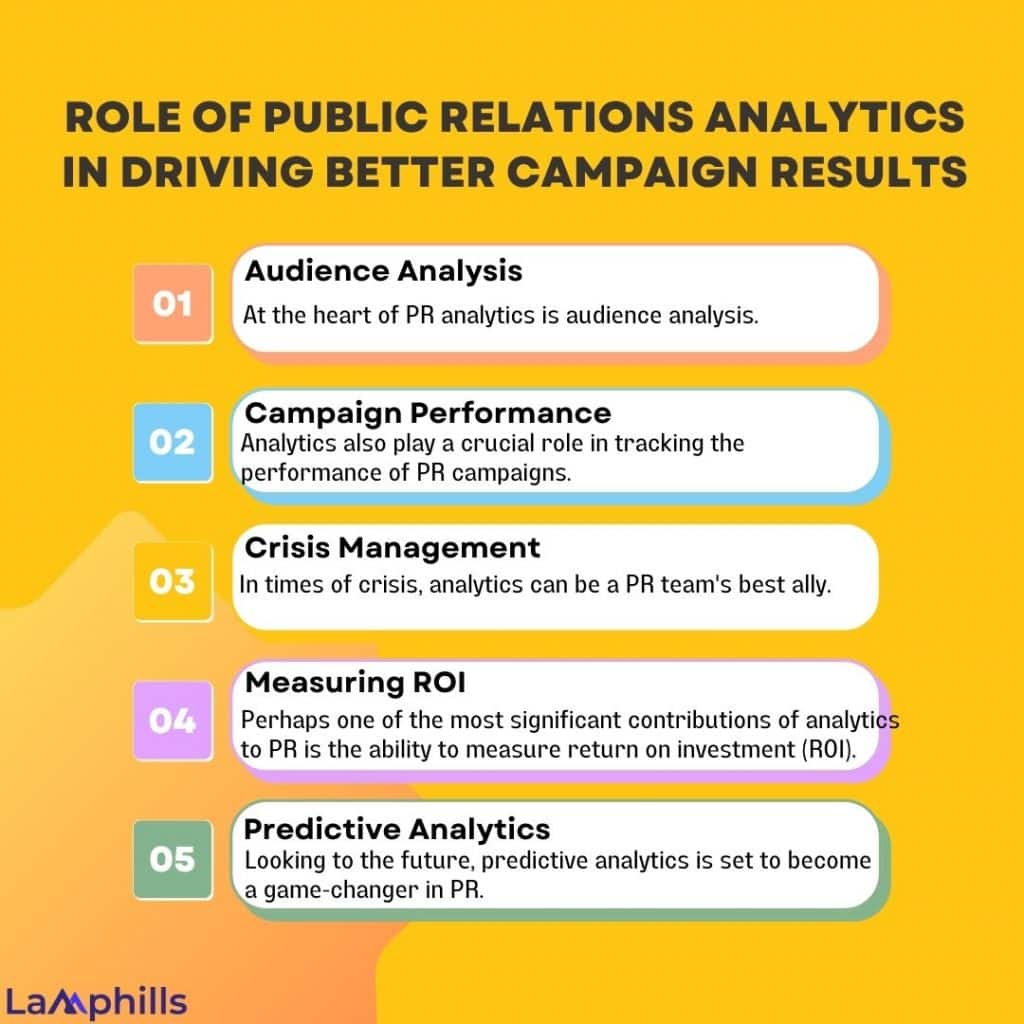A couple of years ago, during a major product launch in our company, our team leveraged public relations (PR) analytics to track media coverage and audience sentiment in real-time. As a result, we maximized positive press and engagement by identifying key influencers and adjusting our messaging based on feedback. Consequently, what happened after that product launch was indeed massive. Specifically, that particular data-driven approach led to a 30% increase in media coverage and a 20% boost in customer interest compared to our previous campaign, proving the power of analytics in refining PR strategies.
Furthermore, the quest to quantify success in public relations has led to an increased reliance on the power of analytics. Gone are the days when PR professionals solely relied on subjective metrics and gut feelings to evaluate the success of their campaigns. Today, the industry has shifted towards a more empirical and data-driven approach to measuring the impact of communication strategies.
In this article, we aim to explore the role of analytics in public relations in driving better campaign results. As PR becomes more intertwined with digital marketing, the need to demonstrate concrete results has never been more pronounced.
Key Points
- PR analytics refers to the systematic analysis of data related to public relations campaigns to assess their performance and impact.
- PR analytics tracks various metrics, from media impressions and social media interactions to audience sentiment toward content.
- The roles of public relations analytics in driving better campaign results include audience analysis, campaign performance, crisis management, measuring ROI, and predictive analytics.
- Public relations (PR) analytics software allows companies to measure the effectiveness of their PR campaigns.
Understanding Public Relations Analytics

PR analytics refers to the systematic analysis of data related to public relations campaigns to assess their performance and impact. As the backbone of any data-driven PR strategy, analytics provides insights that guide decision-making and help optimize communication efforts.
Public relations has always been an industry focused on crafting the right message for the right audience. However, with the advent of digital media, there’s been a paradigm shift towards a more data-driven approach in PR, known as PR analytics. This method systematically measures the performance and impact of PR campaigns, providing invaluable insights into their effectiveness.
At its core, PR analytics tracks various metrics, from media impressions and social media interactions to audience sentiment toward content. These data points provide a comprehensive view of how a campaign performs, what’s resonating with the audience, and what aspects may require retooling. It allows PR professionals to move beyond traditional methods, such as media clipping counts or the estimated advertising value that once dominated the sector, to leverage concrete, actionable data.
Why PR Analytics Matters
If you can relate to the experience I narrated in my introduction, you can easily see and effectively understand why PR analytics matters. PR analytics involves collecting, analyzing, and interpreting data related to PR campaigns, media coverage, social media engagement, and more. It plays a pivotal role in PR strategies for several reasons:
#1. PR Analytics Help You Get More Targeted
In PR, outreach is an essential function for gaining earned media. You want to get positive stories about your company or client into as many top-tier channels and industry trades as possible. But spamming journalists with mass emails wastes time and can quickly land you on the “ignore” or “block” lists. A recent survey shows that a quarter of journalists get between 50-100 pitches weekly. While writing a killer pitch can improve your odds of garnering coverage, the reality is only a handful of journalists might cover one or two of these stories, if that. Knowing which media to target is essential.
For example, software giant Adobe sent out pitches to around 3,000 outlets. However, after they analyzed their coverage, the company discovered that 65% of these outlets produced only one story about Adobe in the past year, while a group of about 500 outlets generated 75% of all quality coverage. Adobe now focuses on this smaller group of outlets because the shift to quality over quantity saves time, effort, and money – and produces better end results.
Adobe’s approach reflects a growing trend: Companies use data to re-engineer PR strategies and zero in on opportunities that drive customer action, not just coverage.
#2. PR Analytics Help You Understand the Behavior of Your Audiences
Now, analytics aren’t new. But in a world of 24/7 unencumbered access to global news and information, social platforms, and online communities, the model for managing customer engagement and service is a far cry from years past—and PR roles in that process are moving to center stage.
Technology has advanced so that it’s possible to know and understand who saw earned media stories about your company or client. The software can create audience personas by accessing demographics, firmographics, household data, purchase intent, and more. From there, readers can be tracked to see if they visited the corporate website — days or weeks later — and what they did next. You can also view the social amplification around your coverage and get a front-row seat to ongoing conversations about your brand.
All of this leads to better intel on how audiences are experiencing your brand and how to convert them to buyers. Without the ability to follow audience behaviors, it isn’t easy to know what worked, what didn’t, how to improve, and where to invest more time and resources.
#3. PR Analytics Help You Justify Budgets and Campaign Spend
Let’s be honest. Regarding budget and resources, P.R. has historically not received as much love (and funding) as marketing and sales have. That dynamic hasn’t changed enough in the current economic environment, with budgets facing more scrutiny as companies look to cut costs.
The struggle is real because quantifying the business impact of PR has been difficult, and now teams are expected to report on metrics that have eluded them in the past. The events of the last few years have highlighted the need to look beyond traditional metrics, tie PR activities back to business outcomes, and underscore the value PR has always brought to the table.
For many, the number of impressions, ad value equivalent (AVE), and share of voice remain the standard, while others have incorporated tracking of social engagement, search engine optimization (SEO) impact, and brand sentiment. However, company leaders expect more and want to see closer alignment with marketing and sales goals.
By tracking audience behavior, PR pros can use data to show tangible evidence that their outreach efforts led to traffic, shopping cart conversions, leads, and ultimately, sales — making it easier to hold on to and, better yet, expand the company’s investment in PR.
How Do You Do a PR Analysis?
A Public Relations (PR) analysis involves assessing the effectiveness of PR efforts and understanding how they impact public perception and business outcomes. Below is a comprehensive checklist guide to conducting an effective PR analysis:
Role of Public Relations Analytics in Driving Better Campaign Results

In the dynamic public relations (PR) field, analytics is the compass that guides strategies and measures success. Integrating analytics into PR practices has revolutionized how professionals understand and interact with their audiences. By harnessing data, PR experts can craft more targeted campaigns, predict media trends, and quantify their impact concretely. This shift towards a data-driven approach is not just about numbers; it’s about gaining a deeper insight into the public’s behaviour, preferences, and feedback. Here are the roles of public relations analytics in driving better campaign results:
#1. Audience Analysis
At the heart of PR analytics is audience analysis. By examining data points such as demographics, online behaviour, and engagement patterns, PR professionals can identify the most effective channels and content types for reaching their target audience. For example, a campaign aimed at millennials might focus on social media platforms like Instagram and TikTok, where visual content reigns supreme.
#2. Campaign Performance
Analytics also play a crucial role in tracking the performance of PR campaigns. Metrics such as reach, impressions, and engagement rates provide a clear picture of how a campaign is performing in real-time. This allows for agile adjustments to be made, ensuring that the campaign remains on track. A successful example is using sentiment analysis tools to gauge public reaction to a product launch, allowing the PR team to address any negative feedback quickly.
#3. Crisis Management
In times of crisis, analytics can be a PR team’s best ally. Real-time monitoring of news outlets and social media can alert teams to potential issues before they escalate. By analyzing the sentiment and spread of information, PR professionals can craft appropriate responses and mitigate damage effectively. The rapid response to a product recall, with timely updates and transparent communication, can often turn a potential PR disaster into a display of the company’s commitment to its customers.
Read also: Crisis Management Plan: Steps To Crafting The Best Crisis Management Plan (+ Free Templates
#4. Measuring ROI
Perhaps one of the most significant contributions of analytics to PR is the ability to measure return on investment (ROI). The value of PR efforts can be quantified by linking PR activities to business outcomes, such as sales or lead generation. This justifies the budget spent on PR and highlights its role in driving business growth.
#5. Predictive Analytics
Looking to the future, predictive analytics is set to become a game-changer in PR. PR professionals can forecast future outcomes and prepare strategies by analyzing past trends and current data. This proactive approach can help anticipate media trends, crises, or campaign virality.
Note: Analytics in PR is not just about collecting data; it’s about transforming it into actionable insights. It empowers PR professionals to make informed decisions, tailor their messages, and ultimately achieve a greater impact. As the PR landscape evolves, those who embrace analytics will find themselves at the forefront, shaping public opinion and driving meaningful conversations.
Check out the template below for the job description of a public relations analyst.
Public Relations Analytics Software
Public relations (PR) analytics software allows companies to measure the effectiveness of their PR campaigns. It provides companies insight into the public relations activities that positively impact traffic and engagement and those that do not. PR teams use this information to assess specific actions’ reach and guide future PR decisions.
These tools can be used by public relations companies to quantify their value to customers and for in-house communications professionals to gain insights into their own campaigns. PR analytics software is often used in conjunction with other public relations software such as press release distribution software, media and influencer targeting software, and media monitoring software products. Press release analytics and distribution software products are important tools in any PR strategy.
To qualify for inclusion in the PR Analytics category, a product must:
- Track PR campaigns related to the user and their company
- Analyze success rates and other metrics based on reader engagement
- Provide detailed reports and analytics of PR-related metrics, along with trends and historical comparisons
Check out these top three PR analytics software below for your effective PR campaign:
#1. Newswire
Newswire is a media technology company that provides its clients with press release distribution services that help build brand awareness, earn media mentions, increase online visibility, improve search engine optimization performance, generate sales, and more. In addition to press release distribution and its Press Release Optimizer, Newswire offers the Media Suite, which bundles its most powerful products into one easy-to-use platform that helps companies maximize their engagement with the media.
Newswire’s relentless commitment to customer satisfaction and its passion for customer performance, paired with its innovative product offerings, continue to help companies of all sizes and industries around the globe deliver the right message to the right audience at the right time.
#2. CoverageBook
CoverageBook is built for busy PR pros, so you can spend less effort reporting on coverage and put your energy into the more important parts of PR. Make coverage reports faster. Trusted by over 13,000 agency and in-house public relations professionals in more than 40 countries. CoverageBook is wonderfully simple to use and super easy to get started. So, you can start making high-impact PR reports that showcase your hard work and impress your clients quickly. No complex training certificate is required.
#3. Launchmetrics
Launchmetrics’ Performance Cloud is a collection of 10+ SaaS apps and services for marketing and communication professionals in Fashion, Luxury, and Beauty. Through its suite of products, customers can make smarter decisions about their branding efforts by digitizing internal processes to optimize their resources and better leverage data as they measure their ROI on campaigns and activations.
Founded in NYC and with its operating headquarters in Paris, Launchmetrics has employees in eight markets worldwide and offers support in five languages. They have been the trusted brand performance technology for brands worldwide, such as Dior, Fendi, Shiseido, NET-A-PORTER, and Adidas, as well as partners such as IMG, the Council of Fashion Designers of America, Camera Nazionale Della Moda Italiana, and the Fédération de la Haute Couture et de la Mode.
Other top public relations analytics software include:
- Meltwater
- Muck Rack
- TVEyes
- Agility PR Solutions
- Critical Mention
- Business Wire.
Bottom Line
Data analytics is no longer an optional component of PR strategy; it’s necessary for success in the digital age. By harnessing the power of data, you can gain valuable insights into your audience, refine your messaging, and measure the impact of your efforts. Whether you’re a PR novice or a seasoned pro, integrating data into your strategy will drive more effective PR campaigns.
Data analytics can be intimidating, but don’t let that deter you. Start small and work your way up. Most of the media monitoring platforms offer free trial periods. Find one that you’re comfortable with and is in your price range, and go from there. Once you start incorporating data into your PR strategy, you’ll wonder how you managed without it.
Similar Articles
- 15+ Public Relations Tools That Work: A Personal Guide to Enhancing Your PR Strategy
- The Role of Public Relations in Tourism and Travel: Practical Tips and Personal Stories
- 15 PR Analytics Hacks That Will Change the Game (Detailed)





